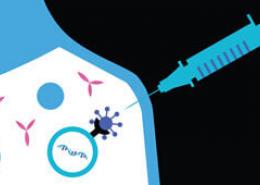MRNA VS. CONVENTIONAL VACCINES

Meet our new Chief Patient Officer, Dr. Dara Richardson-Heron

Working Together to Empower Women

Reducing Health Disparities in Latino Communities

Pfizer Women’s Resource Group

Universal vs. Single Payer Healthcare

Whether you’re a seasoned hiker or have been simply planning more time in the open air lately, warm weather brings a sense of tranquillity — longer days and new vegetation, bursting with birdsong and bug life – some more benign than others! A little awareness can help ensure your family plays it safe. Mosquitoes, fleas, and some flies can carry diseases such as malaria, West Nile virus, Zika, and yellow fever.1,2 Also high on the watchlist are ticks, which are second only to mosquitos for spreading disease in humans if infected with bacteria, viruses or parasites.3 This means that wherever you are in the world, you need to know which bugs and which diseases exist in your immediate surroundings.
The names of some of these tick-borne diseases may be familiar — Anaplasmosis, Babesiosis, Tick-Borne Relapsing Fever, and Lyme disease, which is caused by various species of Borrelia bacteria that live in the gut of ticks.4 Transmission of these tick-borne disease causing pathogens can result in an attack on the immune system, leading to serious health complications such as unstable blood pressure, muscle and join aches, meningitis, neurological problems, respiratory failure and in some cases, even death.5–8
Less common is tick-borne encephalitis (TBE), an infection of the brain and spine that causes symptoms that may be initially mistaken for summer flu.9 Ticks infected with the TBE virus have been found in more than 35 countries across Europe to Japan.10
WHEN TO BE SUPER ALERT
For the most part, ticks are inactive during winter.9 However Raul Isturiz, Global Vaccines Translational Research Lead, says all that changes with a shift of seasons.9 “By the time temperatures nudge the 43°F (6°C) mark, they’re well and truly on the move.9 Unlike many bugs, ticks don’t jump or fly.11 They lay in wait at the top of grasses waving their legs until they make contact with a potential host.”
Like many tick-borne diseases, TBE is on the rise, especially across parts of Europe.10 In Germany, for example, more than 700 cases of TBE were reported in 2020, a rise of almost 60% on 2019, while Austria reported 215 patients hospitalized for TBE in 2020, the highest number in more than three decades.12,13 Lyme disease is even more widespread. More than 300,000 people are diagnosed with Lyme disease each year in the U.S. and more than 65,000 cases a year are reported in Europe.14,15
Some age groups are especially vulnerable. In the last 20 years, the biggest surge in cases of Lyme for example, has been detected in children aged 5-9,16 a time in life when adventure and the outdoors go hand in hand. The blacklegged tick is about the size of a sesame seed when it’s most active and can stay attached to a host for up to 10 days.17 So, it’s important to take precautions.
HOW TO KEEP SAFE BEFORE YOU HEAD OUTDOORS
Find out if the area is known for ticks or other bugs and speak with your doctor to ensure you’re up-to-date with vaccinations or other preventative measures specific to the area. Then check your kit. Use effective insect repellents to treat boots, clothing and camping gear, and wear light coloured clothing which make ticks easy to spot, including long-sleeved tops and trousers tucked into socks.18,19,20 Stick to the centre of the path and avoid heavily wooded areas where the grass or leaf litter is high.18,19
ON YOUR RETURN
Use a mirror to check your body and those of your child for ticks, paying special attention to the area under the arms, in and around the ears, the naval, between the legs and around the waist.18 Generally, people don’t ‘feel’ a tick bite, but may experience a mild itch if the tick is still attached. It’s important to remove attached ticks as soon as possible.18,19,20 Remember that ticks can enter the home on clothing and pets, so throw everything (except the dog!) into a hot dryer for 10 minutes, before washing.
HOW TO REMOVE A TICK
Use fine-tipped tweezers or a tick-removal tool. Grasp the tick as close to the skin as possible, and pull it upwards, taking care not to squeeze or crush it as you go and clean the bite with antiseptic or soap and water.18,19,20
WHEN TO SEEK HELP
See a doctor if you feel you’ve been bitten by a tick or have visited an area in the past month where infected ticks are found and you feel unwell. This may be particularly important if you experience flu-like symptoms including muscle pain, headache, fatigue and a peak temperature above 99.5°F (37.5°C) for two to seven days, or notice a circular red rash, with a bull’s eye centre.8,9,17,20
References:
Source: Read Full Article